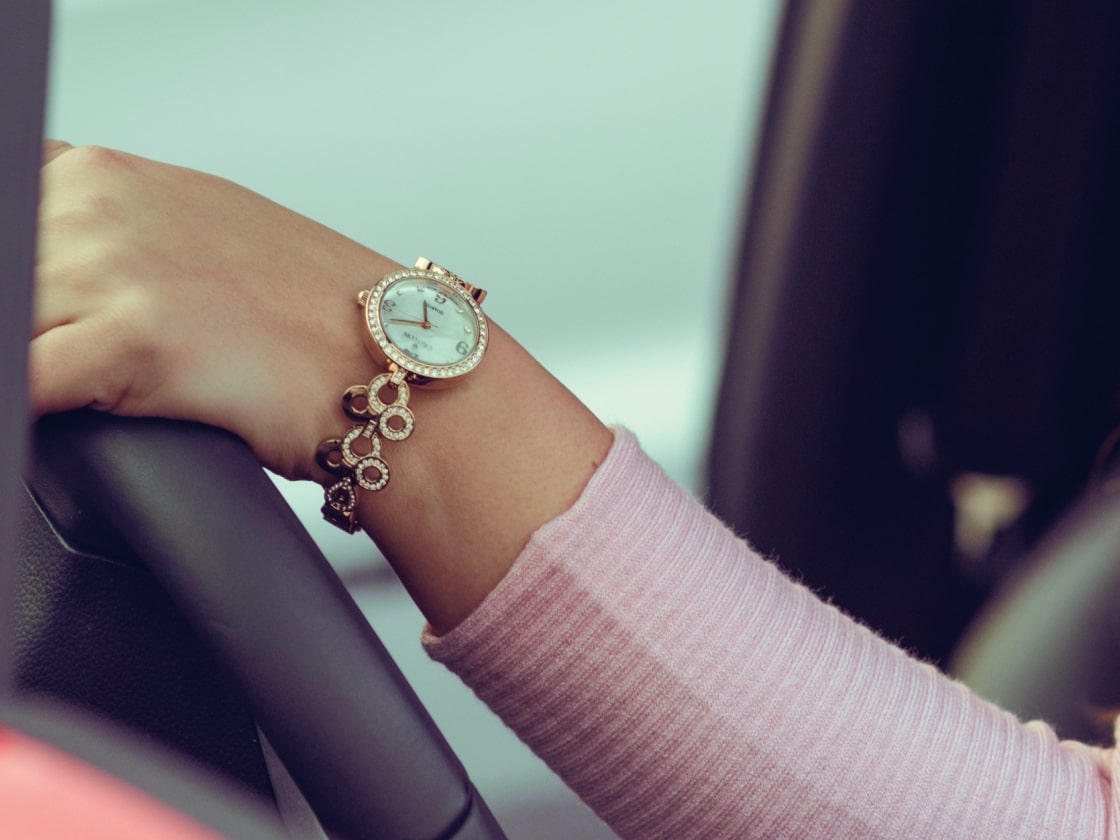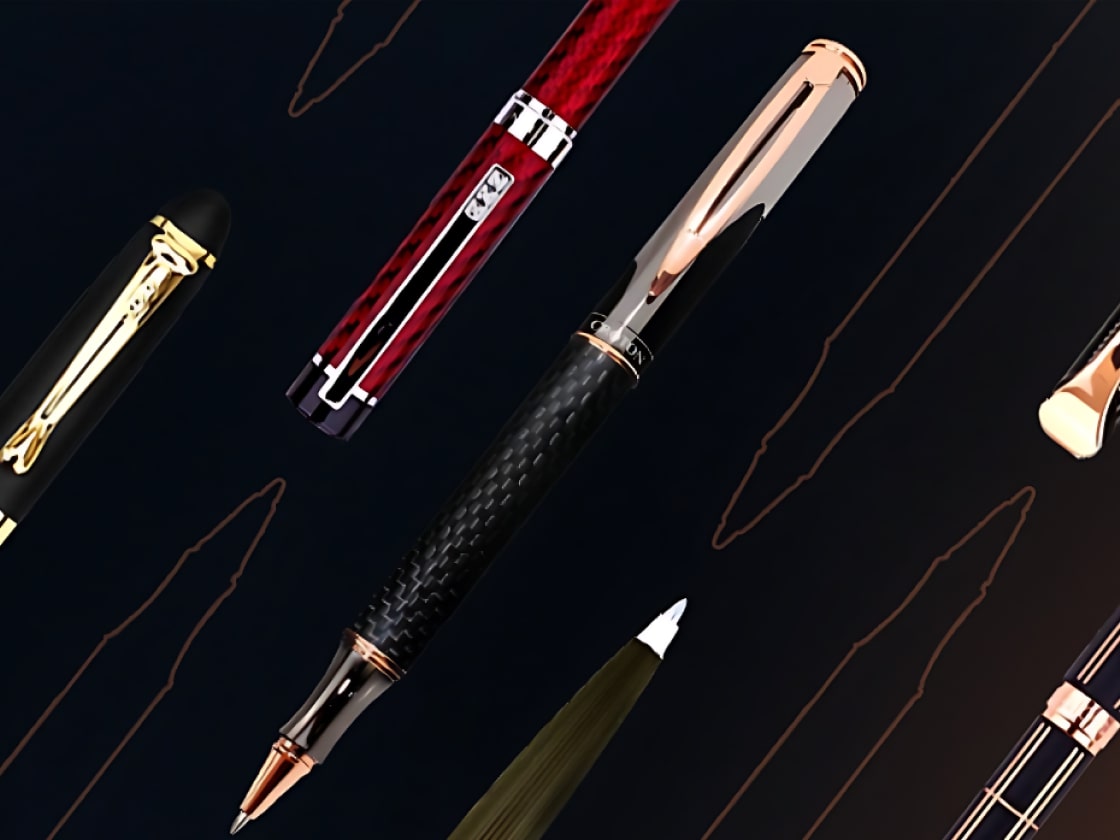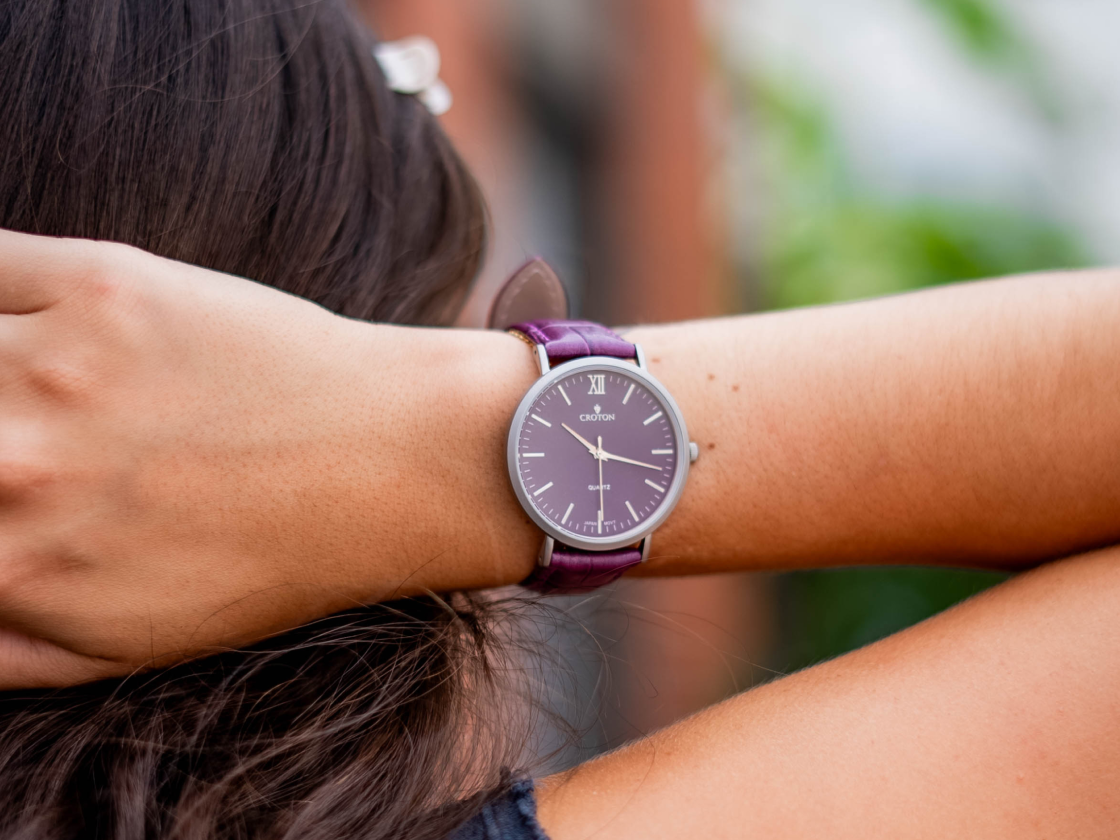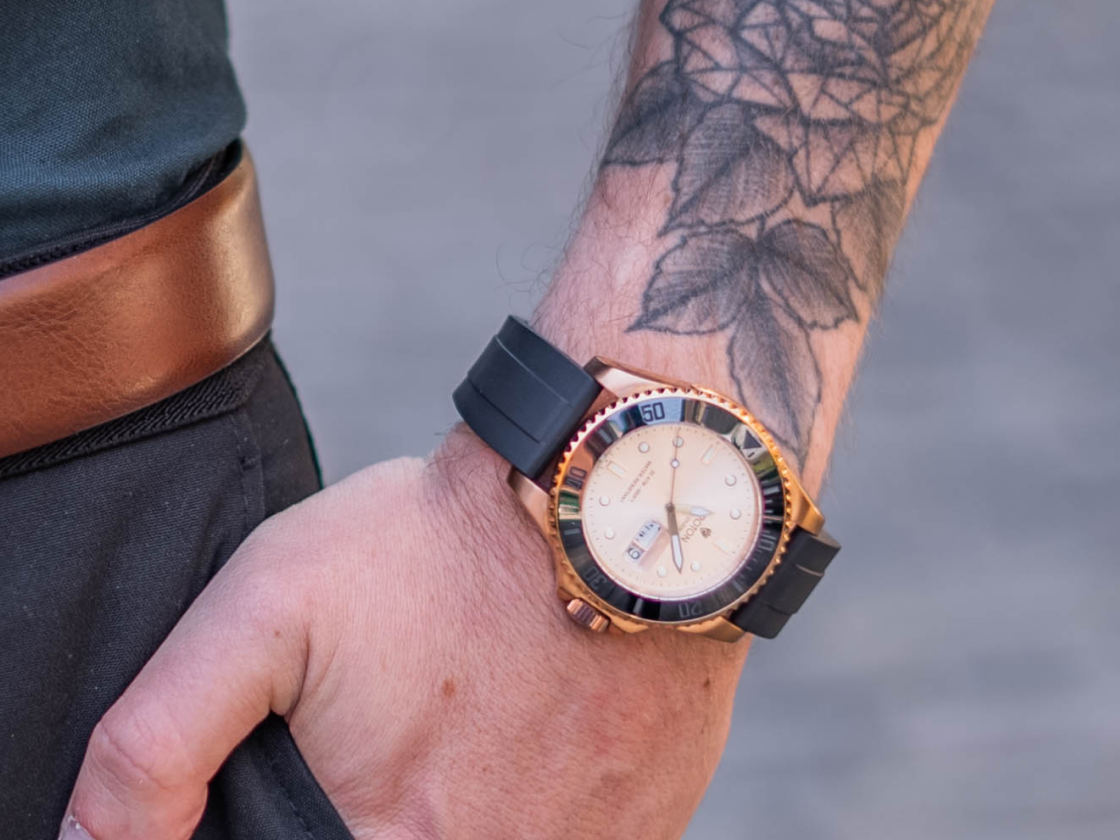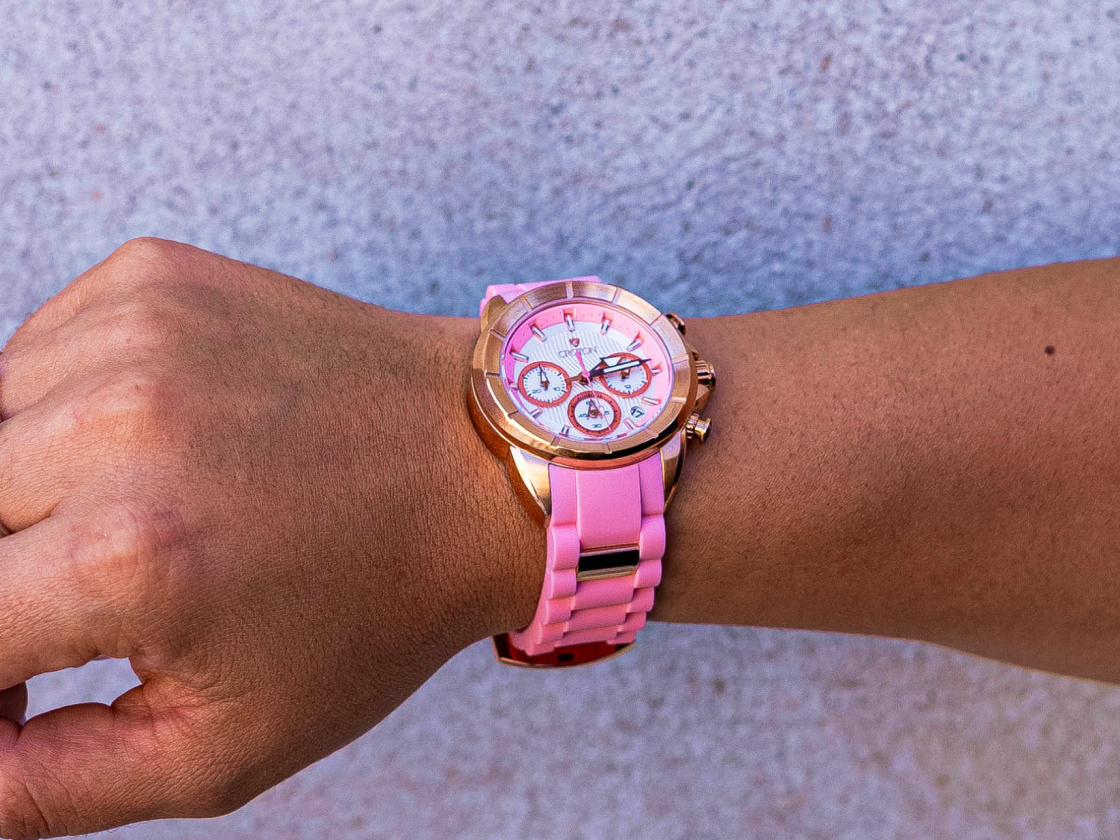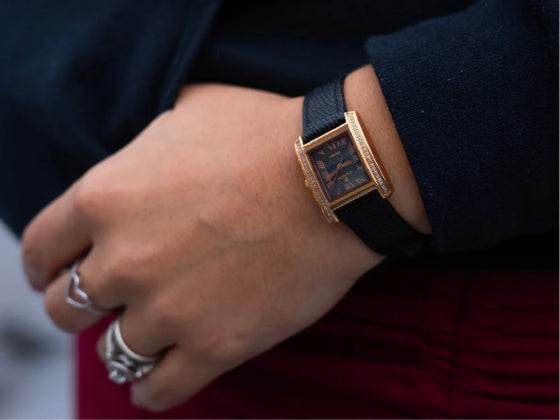Frequently Asked Question
A Sapphire crystal is a lab grown crystal that has the same properties as a Sapphire. The time consuming and labor intensive process used to create and finish these crystals to exacting standards add to the rarity and value of a watch with a sapphire crystal.
Sapphire crystals, which are often coated with an anti-reflective substance, are the hardest lens used on watches because they are difficult to scratch. That's why we use them as the lens of our watches, to protect the hands and dial.
Automatic movement is a subset of mechanical movements and is powered by the wearer's motion.
A fully-charged watch runs accurately for 36-48 hours. If idle, simply shake or wind the crown 20-30 times to recharge. Everyone's wrist movement varies; if accuracy issues arise, our professionals can adjust it for you.
The craftsmanship behind mechanical movements, found in premium watches, amplifies the value of your timepiece.
While Automatic movements are powered by the motion of one's wrist, Quartz movements run off the power of a battery.
These batteries are expected to last between 1.5 - 2 years (depending on the complications, including day, date, chronograph etc.)
Croton tip: Avoid leaving a dead battery inside your watch as it will corrode the movement.
ETA, officially known as ETA SA Manufacture Horlogère Suisse, is Switzerland's premier movement manufacturer, crafting both Quartz and Mechanical movements. They dominate, powering 85% of esteemed Swiss watch brands like Omega, Longines, and Croton. Exclusive ETA movements are reserved for select manufacturers, and Croton proudly ranks among them. While Rhonda and ISA are other notable Swiss movement producers, ETA remains unparalleled in its legacy and precision.
A screw down crown helps protect your watch from moisture and dust. While wearing the watch, the crown should always be left in the locked position.
To set your watch: Release the crown by turning counter-clockwise (down toward the 6 O’clock position). This will enable you to extend the stem and set the time, date, day, etc. Once your watch is set, push the stem back in place and apply light pressure while turning the crown clockwise (up toward the 12 O’clock position). Do so until the crown tightens into place.
A chronograph is a stopwatch. Depending on the chronograph movement, a watch can time from 1/20th of second increments, up to 24 hours, although most chronographs time in one second increments. The majority of chronograph movements is Quartz and therefore run on a battery. Because of the difficulty in making mechanical chronograph complications, the movements are hard to come by and are therefore very valuable.
To set the time, gently pull out the stem as far as it goes. Do not over extend the stem. Rotate the stem to set your watch. Once completed, return the stem to its original position.
To set the date, gently pull the stem so that it is half way out. Rotate the stem clockwise (up toward the 12 O’clock position) until the desired date is reached. Once achieved, return the stem to its original position. Please note: your watch can only go up in date, not down.
To set the day, gently pull the stem so that it is half way out. Rotate the stem counter-clockwise (down toward the 6 O’clock position) until the desired date is reached. Once achieved, return the stem to its original position.
Croton offers a limited lifetime warranty on all pieces. Should a defect occur, due to materials or workmanship, Croton will repair it free of charge. $19.95 shipping and handling fee will apply.
Not included: free repair or replacement of batteries, cases, watch bands, straps, dials, crowns, or crystals within the warranty period as these items are subject to “wear and tear” of daily use.
You may take take your watch to any professional jeweler to be sized. If you desire you may send it back to our company repair facility. Additional links are available on certain models only. For links, their is an additional charge. Their is also a shipping charge of $4.95 for shipping parts. There is a nominal charge for new straps. For gold watches, there is a charge for additional links based on the price of gold. We can send the links to you to take to any professional jeweler or you can send us your watch and we will add on the links free of charge. (There is a $10 shipping and handling fee on all returned watches).
Diamond bezels are available for certain models. It generally takes 6-8 weeks for the bezel to be made. Pricing is based on the price of gold and diamonds. Please call for an estimate.
Crocodiles are farmed for their exotic meat as well as their beautiful leather. Crocodiles roamed the earth with dinosaurs many millions of years ago. They have had an enormous influence on many cultures throughout history. In ancient times crocodiles were worshipped as gods of power, protection, fertility and wealth. Today, crocodile leather has become synonymous with luxury and elegance and is an enduring symbol of success.
Ostrich leather is one of the most durable and soft leathers available in the world today. Ownership of genuine ostrich leather products is a must to the person with discriminating taste, who recognizes and admires the distinguished look of the naturally occurring quill textures.
Stingray is a delicacy in the diet of those who live in the Far East. Sought after for millennia, Stingray has had many uses. In ancient times, only the elite Japanese warriors, and Samurai used Stingray leather for the handles of their swords. The natural non-slip texture of the Stingray along with its flame retardant properties makes Stingray leather one of the most difficult leathers with which to work. Today Stingray is prized for its beauty and texture. Every Stingray has a unique identifier diamond shape mark on its back like a fingerprint so no two are alike
There is an INTERNATIONAL agreement known as the Convention on International Trade in Endangered Species of Wild Flora and Fauna (CITES) which protects endangered species. The US is a founding member of CITES and therefore the US fish and wildlife services monitors and controls importation of such wildlife. All animal products being brought in to the United States must be filed with U.S. Fish and Wildlife services. A special license is needed to import and export these products. Most Crocodile species are no longer endangered and therefore some wild hunting is permitted. However, most crocodile meat and hide is farmed. Ostriches are not endangered but are also farmed for their unique meat, feathers and hides. Stingrays are not endangered and are a common food in the Far East diet.
Water resistance of watches is rated based on laboratory pressure tests based on a static position. But many water-based activities involve a lot of movement and other environmental changes. These exceptions to how a watch was rated may challenge or defeat the water protection features of a water resistant watch. In particular, the water resistance rating of a watch does not take in to account sudden, rapid, and repeated water pressure changes, high water temperatures, and sudden changes of temperature.
Taking a shower or bath with your watch is not a good idea. There are a number of things that can affect the water resistance of the watch. Steam can get through a rubber gasket and at times causes condensation on the crystal. Steam is water and therefore can rust a metal movement. A drastic change in temperature between the inside and outside of your shower can also affect the watch. In addition to the hot water issues regarding water resistance, most people do not realize that bath soap is a fine level abrasive. Soap can build up in the small precision joints of the watch bracelet links and over time can wear down the link joints and ruin the bracelet. This is a more serious issue with softer metals, such as gold. But steel can also be worn down this way.
The Federal Trade Commission in the U.S. discontinued the term "waterproof in the late 1960's. This change was brought about by several government organizations, who were investigating truthfulness and accuracy of product labeling and advertising. "Waterproof" was considered to have misrepresented the products as more capable of preventing the entry of water under normal use circumstances than they were actually capable of. The term "water resistant" is now used to describe such watches. There are no technical differences between a waterproof watch and a water resistant watch. They use the exact same methods and technologies to keep water out. The difference is only in what term was considered appropriate to describe it at the time it was made.
The purpose and function of the helium relief valve is a common point of confusion. It has nothing to do with normal underwater diving. Helium does NOT seep into the watch while the watch is in water at any depth. At approximately 250 feet, air becomes toxic due to changes caused by the high pressures at such depths. Special types of ocean exploration vessels are used by those who do very deep sea research. In some of these, a highly helium-saturated atmosphere is used to avoid the air toxicity effect. The purpose of a helium release valve is for people who wear their watch inside the helium-saturated environment for an extended period. Because helium is the smallest atom, it will seep through the watch's seals under the high air (not water) pressures in this environment. If the watch stays in this environment for an extended time, helium will continue to seep in to the watch until the air pressure inside the watch (initially surface air pressure) equalizes to the air pressure in the environment. This becomes a problem when the vessel is brought back up and depressurized. The helium which seeped into the watch over a couple of days cannot seep out any faster. The excess pressure inside the watch needs a way to release faster than it seeped in. It is only in this situation that a watch needs a helium relief valve at all. If a relief valve was not on the watch, the excess pressure would likely escape by pushing the crystal out.
A chronometer is a watch whose movement has been certified by the Controle Officiel Suisse des Chronometeres (COSC). The term chronometer came in to use to describe timepieces accurate enough for ship navigation. In 1973 COSC came in to existence as the official testing and certification control board. The COSC measures the movement’s accuracy over a few days at various temperatures and positions. The COSC certifies both Mechanical and Quartz movements however, since quartz movements are inherently very accurate and have little or no variation based on temperature or position most watchmakers do not go through the expense to certify quartz watches. A few things to note is that some watch companies have more stringent tests done then the COSC provides and therefore they do not go through the expense of testing their movements. The COSC certificate does not certify future accuracy. A mechanical movement’s accuracy can change over time based on the conditions of its environment.
The term Chronometer means that the movement is certified by the Controle Officiel Suisse des Chronometeres (COSC). Therefore a “Certified Chronometer” is a superfluous repetitive and redundant statement that repeats itself.
http://www.amfed.org/t_mohs.htm
Mohs Scale of Mineral Hardness
In 1812 the Mohs scale of mineral hardness was devised by the German mineralogist Frederich Mohs (1773-1839), who selected the ten minerals because they were common or readily available. The scale is not a linear scale, but somewhat exponential.


